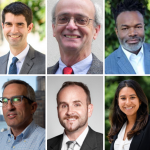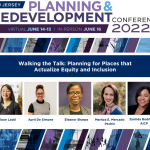New Jersey Future Blog
Geography of Equity and Inclusion: The Big Picture
June 24th, 2021 by Bailey Lawrence
Spatial segregation persists across the United States and continues to result in economic, educational, and health disparities. Nonetheless, according to several planning professionals and activists, equitable approaches, processes, and strategies can help mitigate spatial segregation in New Jersey. At the 2021 New Jersey Planning and Redevelopment Conference, the Geography of Equity and Inclusion: The Big Picture plenary session featured five panelists, including Smart Growth America President and CEO Calvin Gladney, Latino Action Network President Christian Estevez, Fair Share Housing Center Deputy Director Eric Dobson, Tri-State Transportation Campaign Executive Director Renae Reynolds, and David Troutt, Professor of Law and Founding Director of the Rutgers Center on Law, Inequality and Metropolitan Equity (CLiME), Rutgers University. The panel was moderated by New Jersey Future Executive Director Peter Kasabach, and opening remarks were delivered by New Jersey Future Board Members: Cooper’s Ferry Partnership Vice President Meishka Mitchell, AICP, PP, City of Hoboken Director of Community Development Christopher Brown, and Maraziti Falcon LLP Partner Joseph Maraziti.
The speakers provided an overview of spatial segregation in New Jersey, while analyzing the origins of these disparities.
“New Jersey is one of the most diverse states, but it is also one of the most segregated states,” Dobson said. In fact, according to Gladney, “we are getting more segregated year after year” in New Jersey and across the country.
Gladney emphasized that spatial segregation was deliberately established and continues to be purposefully maintained. “It’s not a bug in the system,” Gladney said. “It’s a feature of the system to churn out inequity.” These features include single-family zoning, interstate highways, and redlining.
Such planning decisions, according to Reynolds, have “left communities bifurcated by highways and suffocated by the pollution that comes from the transportation sector.”
Troutt said that, as professionals in the planning field, we must study and act upon these instances of institutional harm, rather than merely acknowledging them in passing. For example, Brown explained that Hoboken’s Master Plan considered how the city’s zoning has motivated the proliferation of larger and more expensive dwellings.
Spatial segregation has important implications for opportunities and health outcomes, and its manifestations may appear in virtually every facet of New Jerseyans’ daily lives.
“Where you live and where you were born can dictate your access to open space, clean drinking water,” and other life necessities, Mitchell said.
During his keynote presentation, Gladney explained that low-income units are being built increasingly further away from transit access across the country, and New Jersey is especially reflective of this trend. On the other hand, the walkability of poor New Jersey neighborhoods is much greater than that of other states’ poorer neighborhoods.
Furthermore, Gladney demonstrated that, in many cities in the United States, the hottest areas are located in the poorest neighborhoods. In many cases, these are the same neighborhoods that were redlined nearly a century ago. Climate change and rising temperatures will disproportionately impact these neighborhoods, which did not receive sufficient investments in the form of tree canopies and porous and/or reflective pavement. Communities most vulnerable to increasing flooding are disportionately the homes of poorer people, as well, Gladney said.
However, the speakers described ongoing initiatives that seek to inhibit spatial segregation and prescribed tactics that conference attendees can utilize in their own communities.
For example, Maraziti emphasized the importance of negotiating community benefits agreements, which can help foster more equitable neighborhoods.
In terms of the transportation sector, Reynolds discussed the Tri-State Transportation Campaign’s efforts to expand the times of transit service, increase access to New Jersey’s trails, and generate connections from “rails to trails.”
“The pandemic brought to light the need for more access to green space,” Reynolds said.
The speakers also outlined strategies in the housing realm that may help combat spatial segregation. Dobson urged urban jurisdictions—especially cities in which gentrification is an intensifying threat—to more consciously implement inclusionary zoning. In Hoboken, for example, the City is adjusting the zoning code to promote housing diversity and affordability, Brown said.
Nonetheless, both Dobson and Estevez acknowledged that it will take decades to truly achieve residential desegregation. Estevez said that, in the meantime, communities must work to expand access to equitable education. Through its ongoing legal efforts, the Latino Action Network is attempting to “realize the promise of Brown” and produce “[really] integrated schools, and then hopefully housing that follows.”
Many of the speakers acknowledged this historical moment as a unique opportunity to effect substantive change and provided effective strategies to conceptualize and evaluate equity.
During this “age of equity,” said Troutt, we must “recognize that the Mt. Laurel doctrine is really about affirmative aspirations. It’s not just about the least that we can do, but the most that we can think about doing.” In order to achieve equitable outcomes, analysis must help formulate “specific equity targets,” and practitioners must engage in “serious compliance, reconciliation, and accountability,” Troutt said.
“We have to make decisions [and] investments with equity in mind” and “centering racially equitable outcomes and fixing racial disparities as the core” of decision-making, Gladney said.
Related Posts
Tags: equity, geography of equity and inclusion, NJPRC21, Planning and Redevelopment Conference, segregation
















